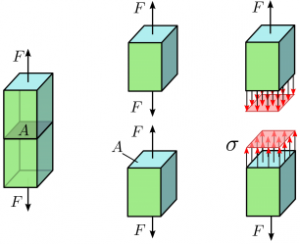Stress and Strain
When a stretching force (tensile force) is applied to an object, it will extend. We can draw its force – extension graph to show how it will extend. Note: that this graph is true only for the object for which it was experimentally obtained. We cannot use it to deduce the behaviour of another object even if it is made of the same material. This is because extension of an object is not only dependent on the material but also on other factors like dimensions of the object (e.g. length, thickness etc.) It is therefore more useful to find out about the characteristic extension property of the material itself. This can be done if we draw a graph in which deformation is independent of dimensions of the object under test. This kind of graph is called stress- strain curve.
Stress: When an external force is applied to a body then at each cross section of the body an internal restoring force is setup which tends to restore the body to its original state. The restoring force setup inside the body per unit area is known as stress.
\(Stress\,(\sigma)\,=\,\,\frac{\operatorname{Re}storing\,\,Force\,(F)}{Area\,(A)}\)
Where,
σ = Stress Applied
F = Force Applied
A = Area.
Stress is expressed in N/m². Stress applied to a material can be of two types:
Stress applied to a material can be of two types:
- Tensile: It is the force applies per unit are which results in the increases in length (or area) of a body. Objects under tensile
- Compressive: It is the force applied per unit area which results in the decrease in length (or area) of a body. The object under compressive stress becomes thicker and shorter.
Strain: The strain is the amount of deformation experienced by the body in the direction of force applied, divided by initial dimensions of the body. The relation for deformation in terms of length of a solid is given below.
\(\varepsilon \,=\,\frac{\delta \,l}{L}\)
ε = Stain due to Stress applied
δl = Change in length
L = Original Length of the Material.
The strain is a dimensionless quantity as it just defines the relative change in shape.
Depending on stress application, strain experienced in a body can be of two types.
They are:
- Tensile Strain: It is the change in length (or area) of a body due to the application of tensile stress.
- Compressive Strain: It is the change in length (or area) of a body due to application of compressive strain. When we study solids and their mechanical properties, information regarding their elastic properties is most important. These can be obtained by studying the stress – strain relationships, under different loads, in these materials.
